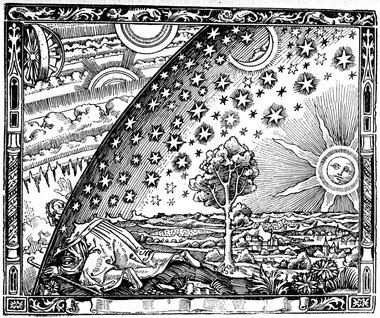John Hurrell – 29 September, 2009
It seems to mean let your imagination leap across the void of common sense to grasp the significance of this wondrous event. Like the kneeling man in the wood engraving, ignores the world of logic.
Auckland
Out Of This World
Curated by Leonard Emmerling and Stephen Bambury
17 September - 16 October 2009
The title of this international exhibition Out of this world refers to the well known, 1888 anonymous line engraving (made from a wood block) of a pilgrim poking his head through the bubblelike membrane that encloses the natural world , the enclosing sphere made of scientific explanation, in order to see the divine and inexplicable forces in action beyond. The experience of encountering the incomprehensible, a magnitude so vast we cannot grasp it, what we also call ‘the Sublime’, is the theme here.
The show examines artists’ attempts to capture this - some sincere, others humorous - and whether it can be upheld as proof of a Supreme Being. It also introduces unjustified belief, the notion of ‘leaps of faith’, dividing the artists into two camps: believers and sceptics.
Actually McCahon is the only ‘believer’ here, apart from the anonymous wood engraver, and the only New Zealander. What that suggests I’m not sure. Certainly that such mystics are outnumbered, particularly in today’s art world - judging by this exhibition. However it is a great McCahon work, with impeccably handled dry paint on jute, showing the comet Kohoutek streaking across the sky in three separate, butted together, charcoal coloured hangings. The word ‘Jump’ on the far left declares McCahon’s risky faith. It seems to mean let your imagination leap across the void of common sense to grasp the significance of this wondrous event. Like the kneeling man in the wood engraving, ignores the world of logic.
The prints by Vija Celmins of night skies or expanses of ocean come closest to McCahon in terms of an intimate sized work that confronts the viewer with enormity. These small works draw you in close but they could be pro-Mystic or pro-Science. The two viewpoints are not necessarily in opposition.
One artwork that implies that it is the viewer alone who is generating any mystical being ‘out there’ is the hologram by James Turrell. It alters its soft, vivid green, rectangular shape as you approach or move around it, depending on your bodily relationship to its glass slab and the illuminating spotlight.
Another particularly gorgeous work connected to the body is a deep velvety black, horizontal rectangle by Peter Rösel. He has lightly flicked specks of white toothpaste over it from a toothbrush. In this way the painting becomes an open mouth, implying God has an oral orifice and is a human creation that mimics ourselves.
Thomas Ruff plays a similar sort of game with his enormous glossy photograph of a night sky, where he states he is prone to adding one extra hand-painted star. Unlike Rösel where God imitates people, Ruff imitates God, yet giving him the human attribute of mischievousness.
Ben Rivers has a grainy five minute film of snippets made with a hand-held camera showing lines of pilgrims apparently ascending the Irish volcanic hill of Station Island on Lough Derg where St. Patrick lived. The added soundtrack plays the noise of incessantly trampled scoria, yet Catholic pilgrims are meant to go barefooted around certain shrines on the way. This hints that perhaps that the film is faked. The Purgatory pilgrims in this film keep their boots securely fastened.
Such fakery is further explored in Linda Quinlan’s two channel film of her version of McNaught’s comet seen two years ago over Tasmania. Her film is a double exposure that seems to include a Milky Way of oil droplets floating on water. The main image is based on a lamp placed in a forest with a cloth thrown over it that has a circular hole cut in. This creates a diagonal beam of light amenable to being crossed by dust clouds. In the background stars are formed from the surrounding, reflecting, glossy leaves.
Modernist art history and the so-called Death of Painting is laughed at by Jorge Molder through his film of what seems to be Malevich’s famous 1913 Suprematist work, Black Square. This ‘full void’ that established a ‘supremacy of pure feeling’ representing God (‘I search for God. I search within myself for myself’) is lampooned when it becomes a trapdoor in a ceiling that opens so that a besuited gentleman can then escape.
The fleeing gent could be a Suprematist painter or he could be God. He could be a modern version of the observer poking his head through the firmament, reversing, pulling his head back out and coming down to earth. This is a wonderful, exceptionally cohesive, exhibition that is witty and light, yet absorbing in the way it counters the position of say, Natasha Conland’s Mystic Truths of two years ago, in relation to ‘outer-worldly’ states of mind. An important show to see.
Images from top to bottom: anonymous, Colin McCahon, Vija Celmins, James Turrell, Ben Rivers, and Linda Quinlan.






 Two Rooms presents a program of residencies and projects
Two Rooms presents a program of residencies and projects Advertising in this column
Advertising in this column



This Discussion has 0 comments.
Comment
Participate
Register to Participate.
Sign in
Sign in to an existing account.